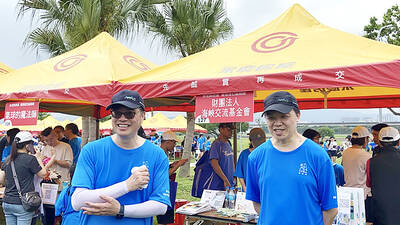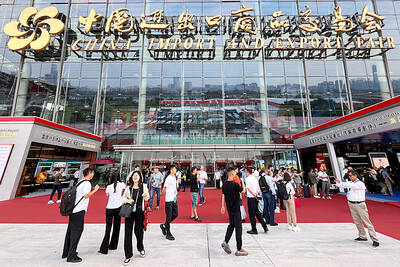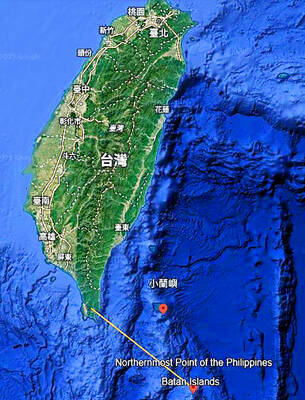A Philippine Supreme Court justice on Thursday launched a book that questions China’s historic claims to most of the South China Sea and said he would distribute it online to try to overcome China’s censorship and reach its people.
Supreme Court Senior Associate Justice Antonio Carpio said his ebook can be downloaded for free in English, while it would be made available later in Mandarin, Vietnamese, Bahasa, Japanese and Spanish to help more people understand the basis of the Philippines’ stand against China’s territorial claims.
Carpio said public opinion, including in China, can help pressure Beijing to comply with an arbitration ruling last year that invalidated China’s historic claims based on a 1982 maritime treaty.
Carpio helped prepare the arbitration case, which the Philippines largely won.
China has dismissed the ruling and continued to develop seven artificial islands in the South China Sea’s Spratly Islands (Nansha Islands, 南沙群島). China’s construction of the islands on disputed reefs has alarmed rival claimants and the US.
“This book in its printed form can never be distributed in China. It will be banned,” Carpio said at the launch of his book in Manila. “The only way this ebook can reach the Chinese people is in electronic format through the Internet.”
“I believe that like all other people of the world, the Chinese people are inherently good, but their government has drilled into their minds that they own the South China Sea since 2,000 years ago. This is, of course, utterly false and the world will never accept this,” he said.
Officials at the Chinese embassy in Manila were not immediately available for comment.
In the book, titled The South China Sea Dispute: Philippine Sovereign Rights and Jurisdiction in the West Philippine Sea , Carpio uses old maps, photographs, excerpts from the arbitration ruling, Chinese government statements and documents to question the validity of China’s claims.
Former Philippine secretary of foreign affairs Albert del Rosario, who spearheaded the filing of the arbitration case against China in 2013, praised Carpio for promoting the rule of law and how that worked well for a small country standing up to a superpower, saying: “International law is the great equalizer.”
He gave a speech at the launch of Carpio’s book and said they stood together with most Philippine citizens in agreement that international rule of law applied to all.
Carpio’s studies on the South China Sea disputes are not part of his work on the Supreme Court.
He said he in 2015 asked the court’s permission to give lectures in 17 countries to explain the territorial conflicts, which many fear could become Asia’s next flash point.
Carpio warns in the book that China might be planning to build more island outposts at the North Luconia Shoals (北康暗沙) and South Luconia Shoals (南康暗沙) off Malaysia and the Scarborough Shoal (Huangyan Island, 黃岩島) off the northwestern Philippines.
If it constructs an island base at Scarborough, China would have enough radar coverage of the South China Sea to be able to impose an air defense identification zone similar to what it did a few years ago in the East China Sea, where it has territorial disputes with Taiwan and Japan, he said.
China and the Philippines, along with Taiwan, Brunei, Malaysia and Vietnam have overlapping claims to parts or all of the South China Sea that straddles busy sea lanes and are believed to be atop undersea deposits of oil and gas.

SECURITY: As China is ‘reshaping’ Hong Kong’s population, Taiwan must raise the eligibility threshold for applications from Hong Kongers, Chiu Chui-cheng said When Hong Kong and Macau citizens apply for residency in Taiwan, it would be under a new category that includes a “national security observation period,” Mainland Affairs Council (MAC) Minister Chiu Chui-cheng (邱垂正) said yesterday. President William Lai (賴清德) on March 13 announced 17 strategies to counter China’s aggression toward Taiwan, including incorporating national security considerations into the review process for residency applications from Hong Kong and Macau citizens. The situation in Hong Kong is constantly changing, Chiu said to media yesterday on the sidelines of the Taipei Technology Run hosted by the Taipei Neihu Technology Park Development Association. With

CARROT AND STICK: While unrelenting in its military threats, China attracted nearly 40,000 Taiwanese to over 400 business events last year Nearly 40,000 Taiwanese last year joined industry events in China, such as conferences and trade fairs, supported by the Chinese government, a study showed yesterday, as Beijing ramps up a charm offensive toward Taipei alongside military pressure. China has long taken a carrot-and-stick approach to Taiwan, threatening it with the prospect of military action while reaching out to those it believes are amenable to Beijing’s point of view. Taiwanese security officials are wary of what they see as Beijing’s influence campaigns to sway public opinion after Taipei and Beijing gradually resumed travel links halted by the COVID-19 pandemic, but the scale of

A US Marine Corps regiment equipped with Naval Strike Missiles (NSM) is set to participate in the upcoming Balikatan 25 exercise in the Luzon Strait, marking the system’s first-ever deployment in the Philippines. US and Philippine officials have separately confirmed that the Navy Marine Expeditionary Ship Interdiction System (NMESIS) — the mobile launch platform for the Naval Strike Missile — would take part in the joint exercise. The missiles are being deployed to “a strategic first island chain chokepoint” in the waters between Taiwan proper and the Philippines, US-based Naval News reported. “The Luzon Strait and Bashi Channel represent a critical access

Pope Francis is be laid to rest on Saturday after lying in state for three days in St Peter’s Basilica, where the faithful are expected to flock to pay their respects to history’s first Latin American pontiff. The cardinals met yesterday in the Vatican’s synod hall to chart the next steps before a conclave begins to choose Francis’ successor, as condolences poured in from around the world. According to current norms, the conclave must begin between May 5 and 10. The cardinals set the funeral for Saturday at 10am in St Peter’s Square, to be celebrated by the dean of the College